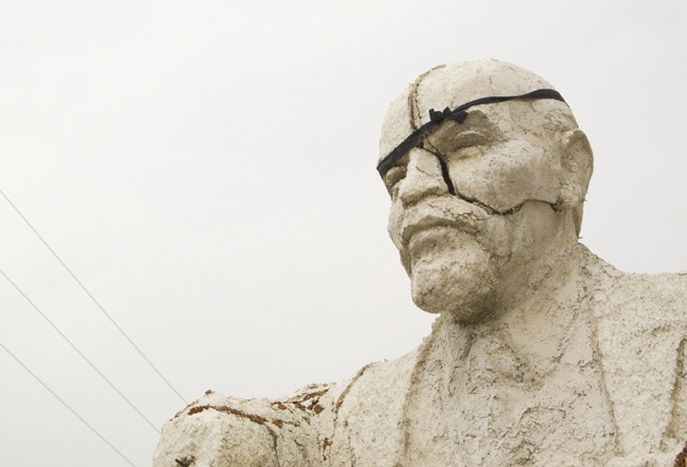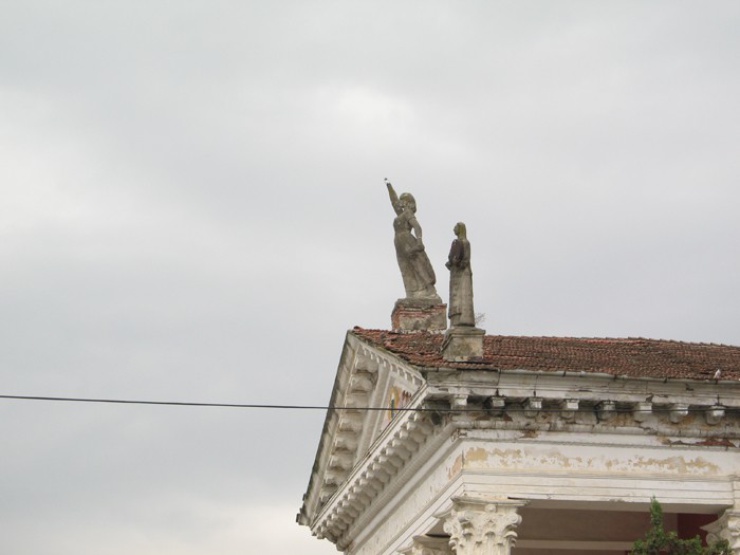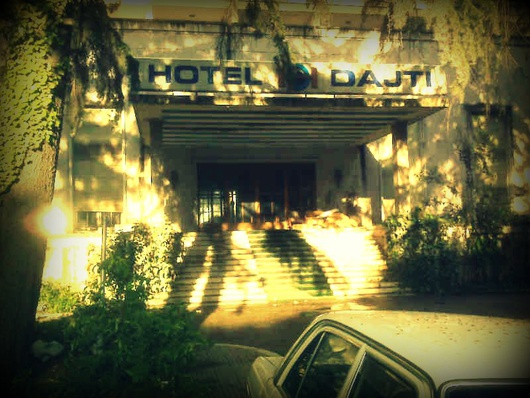
There's no place for art in Tirana
Published on
Translation by:
 sally harbinson
sally harbinson
One German visitor paints a bleak picture of the Albanian capital as a city of art and culture. In delapidated surroundings, the small seeds planted by creative folk via the Marubi academy and Tirana international contemporary art biennial struggle to grow
Taxis wait in the dust at the Kinostudio ('cinema studio') terminus at the end of the North Tirana line. An old truck from Hanover advertises Osram lighting. It’s here that you’ll find the old Albanian cinema studios, whose main building features ornate columns and classical statues. Various cinema and television companies operate from there, along with the Marubi film & multimedia academy - an institution in open conflict with the state. Since last summer, the tension has moved up a notch and there have been occupations and fighting. Access to the academy is now protected by a fenced-off enclosure, and security guards patrol the area beyond the gates, in a sculpture garden created by the academy.
Kujtim Cashku, a filmmaker and director of the academy, was asked if this small piece of land could be rented. The 59-year-old opposed the idea. The recently-dismissed Albanian culture minister had wanted to move the TV station Top Channel from the top of the Enver Hoxha pyramid structure in the city centre to here. 'But why here,' Cashku had justifiably ranted, 'when there are so many empty plots? Why should a garden disappear and not one of the many bits of wasteland?'

Along the length of the railings that block the road, the academy has attached a long banner illustrating the violence of the state, with which students and teachers have clashed during protests. Cashku claims to have sufficient footage to make a film on this subject. And, in his opinion, the Marubi academy has 'the power of images' on its side. Worse still, this fenced-off enclosure exists while, in this week in October 2009, the fourth international human rights film festival is taking place. Next to the main bulding painted in red, which previously housed the national cinema studio, you can see a huge poster for the festival and abandoned iron bleachers. For this filmmaker, this symbolises all the interest that the state has in culture and art.
Biennial at the hotel
The Kinostudio terminus is on the outskirts of the city. A bit further still, a cable car climbs the Daiti mountain forest. In the city centre, Hotel Dajti used to be reserved during Albania’s communist days for wealthy visitors and foreigners. In 2002, it closed and was soon looted. Each attempt to acquire this building has ended in failure. The fourth edition of the Tirana international contemporary art biennial (Ticab) finally took control of the area in June 2009. As a completely empty space, it is well suited to this type of artistic display: on 29 October 2009, the film Feedback ’89 was shown there duing the German cultural weeks. Now, it’s the foreign affairs minister who wants to set up office in Dajti, which a biennial associate is strongly against. It’s a shame, she says. 'The Ticab has not only made it possible to show contemporary works of art here, but we have also showcased a building which is bursting with memories and meaning, built during the Italian occupation, during the fascist era of the 1930s.'
 Also this year, some artists exhibiting during the biennial have integrated the hotel’s relics in their work: you can see imposing sculptures built from broken plates, drawings alongside piles of papers, screenings onto closets with broken doors. Black cobwebs 'decorate' the vast ballroom. The state of this building is a good reflection of the state of the city, which aspires to riches while walking on tired, worn streets. The art here refers to contemporary economic life - in other urban spaces: dead malls in the US, stray dogs in China.
Also this year, some artists exhibiting during the biennial have integrated the hotel’s relics in their work: you can see imposing sculptures built from broken plates, drawings alongside piles of papers, screenings onto closets with broken doors. Black cobwebs 'decorate' the vast ballroom. The state of this building is a good reflection of the state of the city, which aspires to riches while walking on tired, worn streets. The art here refers to contemporary economic life - in other urban spaces: dead malls in the US, stray dogs in China.
Lazy Sundays
There is more activity in Tirana’s market than there is in its shopping centres. The main squares in the city are characteristic of the Italian architecture of the fascist era. On the horizon, new western-style glass-fronted constructions house luxury shops, away from the city centre. In the old areas of the city centre, a church is being built. Neon advertising signs hang in most shop windows. The facade of a major shopping centre features giant screens, despite the frequent power cuts in both summer and winter. In the south of the city, behind the university and the art school, is a poorly-maintained park, with an artificial lake at its centre. Author in French and Italian exile Ornela Vorpsi has depicted it in her 2004 novel The Country Where No One Ever Dies, where women would wade into the water. They were probably beautiful women, because they were accused of being prostitutes too, according to the debut novel. A small red amphitheatre gleams with crude soviet architectural charm. Here, on Sundays, teenagers and families hang about and enjoy themselves. A production set puts the spotlight on a dark-haired woman with a laptop.
During the week, there’s another matter with visas being sought in the back streets behind the embassies. People form clusters, the police try to avoid outbursts, an embassy employee asks for people to be quiet. These people want to leave the country, which first requires approval. They can’t stand not knowing anything about the overly-opaque procedure. In Tirana, there’s no place for contemporary art, for cinema, or, it seems, for human rights.
Translated from Tirana inszeniert Kunst und Kommerz


